Yakovlev Yak-12 Video - Picture
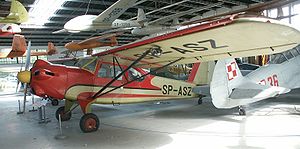
|
|
Yakovlev Yak-12
Yak-12 (Як-12)

Picture - Yak-12 (basic model) at the Polish Aviation Museum
Role: Utility aircraft
Manufacturer: Yakovlev, WSK-OkÄcie, Shenyang
First flight: 1947
Introduced: 1947
Status: In use in civilian aviation
Primary user: Soviet Air Force
Number built: 4,992 (without China)
Developed from: Yakovlev Yak-10
Variants: PZL-101 Gawron
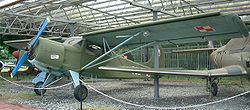
Picture - Polish Air Force Yak-12M
The Yakovlev Yak-12 (Russian: Як-12, also transcribed as Jak-12, NATO reporting name: "Creek") is a light multirole STOL aircraft used by the Soviet Air Force, Soviet civilian aviation and other countries from 1947 onwards.
Design and development
The Yak-12 was designed by Yakovlev's team to meet a requirement of the Soviet Air Force of 1944 for a new liaison and utility plane, to replace the obsolete Po-2 biplane. It was also meant to be used in civil aviation as a successor to Yakovlev's AIR-6 of 1934, built in a relatively small series. Yakovlev's first proposal was a four-place high-wing aircraft, the Yak-10 (first named Yak-14), built in January 1945. It won the competition with a low-wing Yak-13, based on the same fuselage, and a series of 40 Yak-10s were produced, powered with a 108 kW (145 hp) Shvetsov M-11M radial.
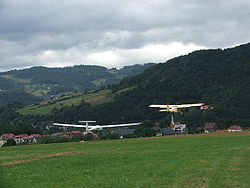
Picture - Polish civilian Yak-12M taking off towing a glider
In 1947, Yakovlev developed a new aircraft to replace the Yak-10. This was fitted with a more powerful 119 kW (160 hp) M-11FR, a new wing and undercarriage, and a fuselage with a revised shape (lower tail). The new type was designated Yak-12, first flying in 1947. 788 of the basic variant were produced, including military observation planes, some Yak-12S air ambulances, Yak-12SKh agricultural aircraft and Yak-12GR floatplanes. A distinguishing feature of the basic Yak-12, just like Yak-10, were engine cylinders with individual cowlings. It was a plane of a mixed construction and could take 1 or 2 passengers, apart from a pilot.
The next generation Yak-12 entered production in 1952, starting with the Yak-12R. It was fitted with a new 194 kW (260 hp) Ivchenko AI-14R radial and all-metal construction. The wing area increased (from 21.6 m² to 23.8 m²). This variant had the least wing loading of all Yak-12s, and therefore best STOL performance (take-off run 52 m/171 ft, landing 81 m/266 ft).
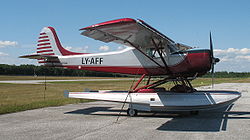
Picture - Tied down at the Franklin County State Airport, Highgate, VT
After being lengthened to improve weight distribution, with further strengthening of the structure and other minor changes, from 1955 the Yak-12M ("modified") was produced. A visible difference was a lengthened, curved tailfin. This variant became more universal, offering a bigger payload. It took a pilot and 3 passengers and could be fitted with dual controls for training, a stretcher for an ambulance role or an agricultural spraying device. It became the most numerous variant.
The last generation, produced from 1957, was the Yak-12A. It was an aerodynamically refined variant, with a slimmer fuselage and a new wing. The cowling wa smaller diameter. The rectangular wings were fitted with trapezoidal ends and automatic slats, also single struts replaced twin struts. Navigation equipment and controls were improved, and performance also increased. In the USSR, 3,801 of Yak-12s were built in all models (including 3,013 Yak-12R, M and A). An experimental Yak-12B biplane was also developed, but did not enter production.
The Yak-12M was licence-built from 1956 in Poland as the WSK-4 Okecie, or Jak-12M (Polish spelling of Russian name). From 1959, the Yak-12A was built in Poland (1,054 Jak-12Ms, 137 Jak-12As), most for export to the USSR. In 1958, further development of the Yak-12M was carried out in Poland, becoming the PZL-101 Gawron.
The Yak-12 was also produced in China as Shenyang type 5.
Operational history
Yak-12s first entered service in the Soviet Air Force as a liaison and artillery observation plane. Then, they were used also in the Soviet civilian aviation - mostly in the DOSAAF aero club for transport, pilot training, parachute training, and glider towing. They were also used as air ambulances and agricultural aircraft.
Apart from the USSR, Yak-12s were used in Poland, Czechoslovakia, Yugoslavia (civil and military), and Hungary (civil). Licence-built Shenyangs were used in China and other countries. In some countries, including Poland, Hungary and Czechoslovakia, the Russian name was transcribed as Jak-12.
In the Polish Air Force, about 90 Yak-12s were used from 1951, as liaison, patrol, and general utility planes. Most were withdrawn in the 1970s, the last in the 1980s. Most were next handed over to civil aviation. In Poland, the first civil model acquired in 1952, and larger numbers were used from the 1960s (at least 79). They were used mostly in regional aeroclubs for pilot training, parachute training, transport, and glider towing. 21 were used as air ambulances.
Some civil Yak-12s (mostly Yak-12A) remain in use in 2006.
Description
Metal construction (Yak-12R, M, A) or mixed construction (Yak-12) braced high-wing monoplane, conventional in layout, metal and canvas covered. Wings fitted with flaps and slats (automatic slats - Yak-12R or fixed - other variants). Four seat cabin (in early variant Yak-12 - 2 or 3 seat). Conventional fixed landing gear with tail wheel.
Single radial engine: 5-cylinder M-11FR (nominal power 104 kW/140 hp, take-off power 118 kW/160 hp) - Yak-12 basic variant; 9-cylinder AI-14R (nominal power 161 kW/220 hp, take-off power 191 kW/260 hp) - Yak-12R, M and A. Two-blade propeller. Two fuel tanks in wings, 225 l (55 US gal) each.
Variants
Yak-12
Basic variant built for military and civilian operators.
Yak-12GR
Floatplane version of the Yak-12.
Yak-12S
Air ambulance version of the Yak-12.
Yak-12SKh
Agricultural version of the Yak-12.
Yak-12R
Improved version of the Yak-12 powered by Ivchenko AI-14R engine and the plane construction became all-metal, built from 1952.
Yak-12M
Main production version with further construction strengthening, a lengthened tailfin and other minor changes, built from 1955.
Yak-12A
Aerodynamically refined version with a slimmer fuselage, engine cover with smaller diameter and some wing modifications, built from 1957.
Yak-12B
Experimental biplane version, not produced.
Shenyang type 5
Yak-12 licence-built in China.
Jak-12M
Yak-12M licence-built in Poland, 1,054 built.
Jak-12A
Yak-12A licence-built in Poland, 137 built.
PZL-101 Gawron
Polish development of the licence-built Yak-12M.
Operators
Military operators
Czechoslovakia
Czechoslovakian Air Force
Mongolia
Military of Mongolia
Poland
Polish Air Force operated Yak-12 aircraft (transcribed as Jak-12) since 1951, as liaison, patrol and general utility planes. Most were withdrawn in the 1970s, the last in the 1980s.
Soviet Union
Soviet Air Force
Yugoslavia
Yugoslavian Air Force
Civil operators
People's Republic of China Czechoslovakia Hungary Poland
Aeroklub Polski since 1952
Air ambulance service
Mongolia
MIAT
Soviet Union
DOSAAF aero club operated Yak-12s for transport, pilot training, parachute training, and glider towing. They were also used as air ambulances and agricultural aircraft.
Yugoslavia
Specifications (Yak-12M)
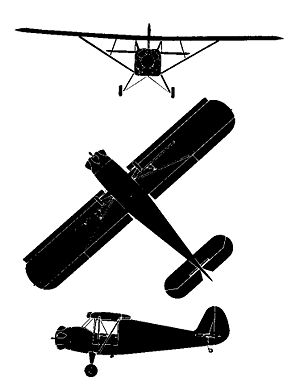
Picture - Yak-12
Data from Soviet Transport Aircraft since 1945
General characteristics
Crew: one, pilot
Capacity: 3 passengers
Length: 9.0 m (29 ft 6¼ in)
Wingspan: 12.6 m (41 ft 4 in)
Height: 3.12 m (10 ft 2¾ in)
Wing area: 23.86 m² (256.8 ft²)
Empty weight: 1,026 kg (2,262 lb)
Max takeoff weight: 1,450 kg (3,190 lb)
Powerplant: 1x Ivchenko AI-14R air-cooled 9-cylinder radial engine, 191 kW (260 hp)
Performance
Maximum speed: 180 km/h (97 knots, 112 mph)
Cruise speed: 127 km/h (69 knots, 79 mph) (economical cruise)
Range: 765 km (413 nmi, 475 mi)
Service ceiling: 4,160 m (13,648 ft)
Rate of climb: 4.1 m/s (807 ft/min)
Take-off run: 153 m (501 ft)
Landing run: 120 m (393 ft)
Specifications (Yak-12A)
Data from Soviet Transport Aircraft since 1945
General characteristics
Crew: one, pilot
Capacity: 3 passengers
Length: 9.0 m (29 ft 6¼ in)
Wingspan: 12.6 m (41 ft 4 in)
Height: 2.33 m (7 ft 7¾ in)
Wing area: 22.61 m² (243.4 ft²)
Empty weight: 1,059 kg (2,334 lb)
Max takeoff weight: 1,588 kg (3,500 lb)
Powerplant: 1x Ivchenko AI-14R air-cooled 9-cylinder radial engine, 191 kW (260 hp)
Performance
Maximum speed: 215 km/h (116 knots, 134 mph) at sea level
Cruise speed: 155 km/h (84 knots, 93 mph) (long range cruise)
Range: 1070 km (577 nmi, 665 mi)
Service ceiling: 4,000 m (13,100 ft)
Rate of climb: 3.6 m/s (708 ft/min)
Take-off run: 153 m (501 ft)
Landing run: 131 m (429 ft)
Related development
Yakovlev Yak-10
Yakovlev Yak-13
PZL-101 Gawron
Comparable aircraft
Fieseler Fi 156
Aero L-60 Brigadýr
Piper PA-20 Pacer
Cessna 170
Gunston, Bill. The Osprey Encyclopedia of Russian Aircraft 1875 - 1995. London:Osprey Aerospace, 1995. ISBN 1 85532 405 9.
Benedykt Kempski: Samolot wielozadaniowy Jak-12, TBiU nr.90, Wydawnictwo MON, Warsaw 1983, ISBN 83-11-06982-4 (Polish language)
Stroud, John. Soviet Transport Aircraft since 1945. London:Putnam, 1968. ISBN 0 370 00126 5.
Living Warbirds: The best warbirds DVD series.
Source: WikiPedia